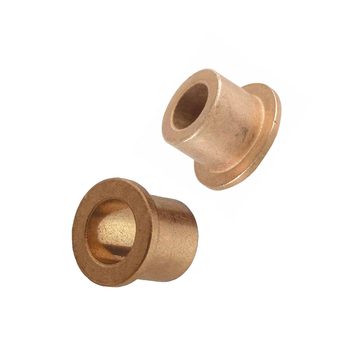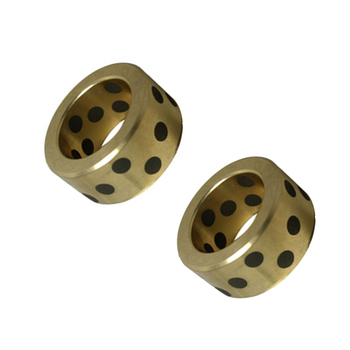Bushings are a critical component of machinery and equipment. According to recent studies, approximately 80% of machine failures can be directly attributed to incorrect bearing selection or installation. With this in mind, choosing the right type of bushing is essential for optimal performance and longevity. This article will discuss two popular types of bushings: brass and bronze, as well as provide helpful tips on how to choose between them.
When it comes to selecting bushings, different materials offer different benefits depending on the requirements at hand. Brass bushings have become increasingly popular due to their strength and ability to resist corrosion. They are also more affordable than some other metals used in making bushings such as steel or aluminum alloys. Bronze bushings, while more expensive, possess excellent wear resistance properties which make them ideal for applications where durability is paramount.
In order to determine whether brass or bronze bushings are best suited for a particular application, one must take several factors into consideration including load capacity, temperature range, speed of rotation (if applicable), surface finish requirements, and cost-effectiveness. This article seeks to explore each option individually in an effort to help readers understand what makes them unique so that an informed decision can be made regarding their choice of bushing material.
Advantages Of Brass Bushings
The flexibility of brass bushings is akin to a tree swaying in the wind- resilient, yet pliable. They are cost-effective and able to handle high loads as well as temperatures without deforming or wearing down too quickly. As an alloy composed mainly of copper and zinc, they offer good strength and hardness while remaining ductile. The anti-galling properties provide superior resistance against corrosion which makes them suitable for use with moving parts that experience regular friction. Furthermore, their malleability allows them to be shaped into complex designs, making it easy to customize according to specific requirements.
In addition, brass bushings have excellent electrical conductivity due to their low resistivity rating; this makes them ideal for applications involving electricity at relatively high currents. Another key advantage of brass bushings is their versatility; they can be used in both hydraulic and pneumatic systems alike without any notable issues arising from either type of system. Finally, when compared to other materials such as bronze or steel, brass bushings are often less expensive than many alternatives, making them even more attractive in certain scenarios where budget constraints come into play. Transitioning seamlessly into the subsequent section about ‘disadvantages’ will require an exploration of how these features may ultimately lead to some drawbacks associated with using brass bushings instead of other materials under certain circumstances.

Disadvantages Of Brass Bushings
Brass bushings are a popular choice for many applications due to their low cost and relative ease of installation. However, they may not be the best choice in all cases. There are several disadvantages to using brass bushings that should be considered before making your final decision.
The first disadvantage is that brass can easily deform over time under heavy loads or when exposed to certain environmental conditions. This deformation can result in an increased amount of friction between the bushing and its mating part, which could lead to premature failure or unexpected performance issues. In some cases, this could also increase maintenance costs if replacement parts become necessary.
Another potential issue with brass bushings is that they do not typically offer as much corrosion resistance as other materials such as bronze bushings. Oil-impregnated versions are available but these may require routine maintenance depending on how heavily the part is used in a given application.
Finally, because brass is soft compared to other metals like aluminum or steel, it does not provide as much protection against wear and tear from repetitive motion or vibration-prone environments. If durability is important for your application, then you might want to consider investing in a more resilient material like bronze instead of relying solely on brass bushing components.
Bullet Point List:
1. Easily deform under heavy load & environmental conditions
2. Not as corrosion resistant as bronze bushing
3. Soft compared to aluminum & steel; less durable than bronze? Less resistant to wear and tear than bushings made from other materials
Advantages Of Bronze Bushings
Bronze bushings have several advantages over brass bushings and other types of bushings, such as plastic. Sintered bronze is a strong material that offers superior wear resistance, making it an ideal choice for applications requiring high levels of performance. The following table summarizes the main benefits of using sintered bronze bushings:
| Benefit | Description | Examples |
|---|---|---|
| Wear Resistance | Sintered bronze has excellent wear resistance, meaning it can withstand abrasion and corrosion better than most materials. This makes them ideal for use in challenging environments where normal wear and tear is expected. | Automotive components, heavy machinery parts, pumps, valves, etc. |
| Service Life | Bronze bushings are designed to last longer than other types of bushings due to their ability to resist wear. They provide a reliable service life with minimal maintenance required. This helps reduce downtime and overall costs associated with replacing worn-out components. | Industrial equipment, agricultural machinery parts, load-bearing structures, etc. |
| Cost Effective | When compared to brass or plastic bushings, sintered bronze tends to be more economical in terms of initial cost and long-term upkeep expenses. Over time this adds up significantly when looking at the total lifecycle costs associated with any given application. | Construction projects, infrastructure overhauls etc. |
Overall, sintered bronze provides reliable performance while remaining cost-effective throughout its entire lifespan – making it an attractive choice for many industries and applications seeking durable solutions without breaking the bank. Moving forward we will explore some potential drawbacks associated with using these types of bushings

Disadvantages Of Bronze Bushings
Aesthetically, bronze bushings have a unique appeal that can add to the attractiveness of some projects. Unfortunately, this comes at a cost; there are several disadvantages associated with using bronze bushings:
- Cost: Bronze bushings tend to be more expensive than brass ones due to their rarity and complexity in production.
- Availability: Not all projects require bronze bushing components as they may not always be available or easily accessible on short notice.
- Corrosion Resistance: While bronze is resistant to corrosion, it is still susceptible to rusting if left unprotected for prolonged periods of time.
- Strength: Although stronger than brass, bronze bushings are less durable and more prone to breakage when compared to other materials such as stainless steel or aluminum alloy.
Overall, while possessing an attractive look, users should consider the potential drawbacks before selecting bronze bushings over brass ones for any project or application. The next step in choosing between these two types of bushings is looking into their properties and comparing them side-by-side in order to make an informed decision about which one best meets their needs.
Comparison Of Properties
When deciding what type of bushing to use, it is important to consider the differences in properties between brass and bronze bushings. Brass is a malleable alloy composed mainly of copper and zinc while bronze is an alloy primarily composed of copper with smaller amounts of tin or other metals. The combination of these materials creates different properties for each material, which can affect performance in various applications.
Brass bushings are highly corrosion-resistant due to their composition. They also have excellent electrical conductivity and good wear resistance. On the other hand, bronze bushings possess better tensile strength than brass but tend to be more brittle when exposed to shock loading or extreme temperatures. Bronze bushings also exhibit superior hardness compared to brass, making them ideal for high-impact applications that require increased durability and strength.
The choice between brass and bronze bushings should ultimately come down to the specific application requirements. If corrosion protection and low friction are a priority then brass may be best suited for the job whereas if greater toughness and impact resistance are needed then opting for bronze could offer improved results. Ultimately, careful consideration must be given to both materials before selecting one over the other. With an understanding of the differences in properties between brass and bronze bushings, users will be able to choose the right type based on their particular needs.
Durability Differences
When choosing between brass and bronze bushings, durability is an important factor. Brass bushings are composed of copper and zinc in various ratios depending on the application. This combination of metals makes them strong yet malleable enough to be machined for specific sizes and shapes. Bronze bushings, by contrast, are typically made from a mixture of copper and tin or lead which provides greater hardness than brass but less flexibility. As such, bronze bushings can withstand higher levels of pressure while being more resistant to corrosion than brass ones.
In terms of wear resistance, both materials offer excellent results as long as they’re properly maintained. However, when exposed to extreme conditions such as high temperatures or corrosive chemicals, bronze bushings generally last longer than their brass counterparts due to the increased level of hardness that comes with their composition.
Overall, it’s important to consider all factors before deciding which type of bushing is best suited for your needs since each material has different qualities that may make one better suited for certain applications over another. With this information in mind, cost considerations will now be discussed to help further inform the decision-making process.
Cost Considerations
When considering the cost of either brass or bronze bushings, a variety of factors should be taken into account. The initial costs to purchase can vary significantly depending on the specific application and type of bushing needed. In general, brass is more economical than bronze due to its relative abundance; however, other considerations such as corrosion resistance, strength requirements, and installation time must also be considered when making this decision.
Corrosion resistance is an important factor in cost consideration because it affects the lifespan of each material. Brass has better corrosion-resistant properties than bronze under certain conditions. However, if there are high levels of moisture present then bronze will have superior resistance against rusting and pitting which may lead to higher maintenance costs in the long run. On the other hand, brass requires less maintenance due to its protective layers that form naturally over time which gives it good longevity without additional expense for upkeep.
Installation time is another factor since labor hours can add up quickly with complex projects requiring multiple bushings. Brass bushings are typically easier to install than their bronze counterparts because they are softer metals that require less torque for fastening them securely in place whereas bronze needs more force applied during installation leading to longer setup times. Ultimately both materials provide reliable results but choosing one over the other could save money in terms of labor costs depending on how complex the project is.
The final cost choice between brass and bronze bushings depends largely on individual applications taking into account all relevant factors including durability differences, corrosion resistance needs, strength requirements, and installation time among others before deciding which option works best for any given situation.
Applications For Each Material
Are you in the market for bushings? Do not worry, because choosing between brass and bronze bushings is now as easy as picking your favorite flavor of ice cream. Whether it be pistachio or bubble gum, there is a bushing to fit every need!
Brass bushings are used mainly in applications involving high temperatures, such as an oven door hinge. They can also be found on furniture pieces like chairs and tables where they provide stability and reduce noise when in use. Bronze bushings have become increasingly popular due to their corrosion resistance properties. These bushings are most often seen in valves, pumps, and other water-based equipment that needs protection against rusting over time.
Because both materials offer unique benefits depending on the application requirements, one must carefully consider which material will best serve its purpose before making a purchase decision. Both brass and bronze come with advantages specific to certain tasks; however, the price may also play an important role in deciding which type of bushing works better for what job. Ultimately, understanding how each material performs under different conditions should help inform any decision about which kind of bushing is needed for a particular project. With this knowledge at hand, users can confidently select the right type of bushing for their needs – no matter if it’s pistachio or bubble gum flavored!
Environmental Impact Differences
When it comes to environmental impact, brass, and bronze bushings are both quite similar. They each require natural resources for production, create waste during the manufacturing process, and can be recycled if needed. However, there is one key difference? brass contains lead whereas bronze does not. This means that when evaluating them from an environmental perspective, one should consider how much lead will be released into the environment as a result of their use.
In terms of energy efficiency, brass bushings tend to have lower thermal conductivity than bronze bushings. As such, they may require more energy to maintain optimal performance levels over time. This could potentially increase the total emissions associated with using these products in certain applications. On the other hand, some applications may benefit from higher thermal conductivity values provided by bronze bushings which could offset this issue depending on individual needs.
Finally, while both materials present challenges in terms of recycling due to their complex chemical composition and heat sensitivity, brass has been found to have better recyclability potential than bronze in some cases due to its relatively simple alloying elements. This makes it a more eco-friendly choice for those looking for sustainable solutions that minimize environmental impacts over the long term. With these factors taken into consideration, we now turn our attention to selection criteria for different projects.
Selection Criteria For Different Projects
Having discussed the differences in environmental impact between brass and bronze bushings, it is now important to explore how one should go about selecting the appropriate bushing for different projects. The selection process must consider several criteria that are unique to each project.
The first criterion is cost-effectiveness. Brass bushings typically have a higher upfront cost than bronze ones but tend to be more durable over time. However, if a project requires frequent replacement of parts due to wear or corrosion, then choosing a cheaper option such as bronze may make sense from an economic perspective. Additionally, factors like the availability of materials and lead times can also affect the decision-making process when considering costs associated with using either material.
Another factor that needs to be taken into account during the selection process is compatibility with other components in use onsite. For instance, certain lubricants used in conjunction with brass bushings may not work well with some types of plastic components often found in industrial machinery or vehicles. In this case, installing bronze bushings might be preferable over brass ones so as not to cause any damage or disruption due to incompatibility issues.
Finally, another consideration when deciding which type of bushing best suits a particular project revolves around its intended purpose and the environment where it will be installed. If working outdoors or exposed to high levels of moisture, both choice metals are likely unsuitable since they could corrode quickly in wet conditions; however, if indoors and protected from water exposure, either metal would perform adequately depending upon the application’s specific requirements and design parameters. With all these considerations accounted for, one can confidently select the most suitable bushing for their given project.
Conclusion
At last, we come to the ultimate decision of which bushing material is superior: brass or bronze. The answer, as with many things in life, is neither one nor the other. Each has its own unique advantages and drawbacks that must be evaluated on a case-by-case basis to determine what works best for each individual application. After all, it’s not about who comes out ahead but rather making sure you get the right bushing for your needs.
When choosing between brass bushings and bronze bushings there are several factors to consider such as cost, strength, corrosion resistance, and even appearance. Brass bushings have low initial costs but may require more frequent replacement due to their relative fragility when compared to bronze bushings. Bronze bushings offer increased strength and durability at higher prices than brass but also tend towards higher rates of corrosion over time under certain conditions.
In short, both options have their merits depending on the situation so make sure you weigh up the pros and cons before committing to either choice! Taking into account factors like budget constraints and the type of load being applied will help ensure optimal performance from whichever option you choose. Ultimately, only experience can teach us how these two materials will perform in any given set-up – so don’t forget that research is key!

